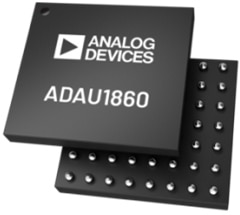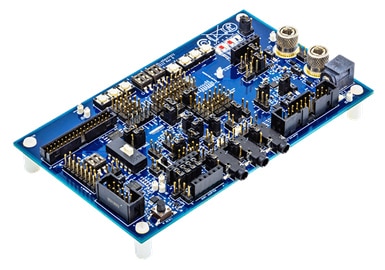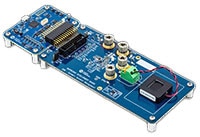ADI Platform Provides Components and Tools for Developing Open-Ear Sound AR Glasses
Contributed By DigiKey's North American Editors
2024-09-11
The integration of spatial audio with augmented reality (AR) glasses can create immersive and interactive human sensory experiences to better bridge the physical and digital divide. But designers need to ensure that audio-enhanced AR glasses are lightweight and provide extended runtime for practical use.
The market for smart AR glasses appears on the brink of substantial growth, with unit shipments projected to increase from just over 676,000 in 2023 to 13 million units in 2030, representing a compound annual growth rate of 53%. Improvements in display quality, battery life, and overall performance will make AR glasses more practical in enterprise, industrial, and consumer use cases.
AR glasses with embedded microphones and speakers provide quick access to voice assistants and music playback. They can be a critical factor in leveraging digital twins on the factory floor, or in providing bicyclists with navigation and performance prompts.
High-fidelity spatial audio can significantly impact the user's AR experience by enhancing the texture, context, and meaning of visual interactions. But getting high-performance audio from AR glasses is especially challenging due to the small form factor that is required to gain user acceptance and satisfaction. Additionally, these devices need to be lightweight and provide extended battery life, which can be particularly challenging when incorporating features such as high-quality audio, video recording, or visual displays into the application.
Along with advancements in processing power and display resolution, audio and power management will play a crucial role in creating successful applications that will maximize demand for these devices. Among the challenges to overcome are:
- Smaller speakers tend to have high resonance frequencies which can damage speakers if driven too hard, and make it more difficult to drive deep bass.
- Noise-free call quality that picks up a wearer's voice while blocking environmental noise is essential, but complicated because of the distances between microphones and the user's mouth.
- Integrating more features requires better battery management solutions to ensure faster charging and longer runtime. The trade-off between weight, function, and runtime is key to widespread market adoption.
- Many use cases require that users not be impeded in their ability to hear what is going on in their surroundings, such as oncoming vehicles or interactions with co-workers.
Open-ear audio
Designers striving to combine visual and auditory information in a natural and realistic way should consider open-ear audio technology. By eliminating the need for headphones or earbuds, open-ear audio provides users the ability to hear both AR sounds and real-world sounds, enabling a seamless and immersive experience without compromising interaction with other users and the environment.
With embedded microphones and open-ear speakers, AR glasses are highly suited for AR as well as virtual reality (VR) and mixed-reality applications. Users can enjoy a more comfortable listening experience without compromising sound quality or fidelity. These devices allow users to hear what is going on in their surroundings so they can maintain situational awareness to ensure safety and collaborate with co-workers or interact with others, while also minimizing the risk—or annoyance—of other people overhearing the audio content.
Engineers can leverage open-ear audio to create electronic applications that combine visual and auditory information in a natural manner. AR glasses with this technology add another layer of realism by providing spatial audio that provides users with sound that appears to come from a specific direction and distance.
Spatial audio will be a key component of open-ear audio development. It creates a realistic and immersive sound environment that matches visual content and the user's perspective. Apple's Vision Pro VR device, for example, features open-ear audio, spatial audio integration, and 3D ear-mapping to improve the immersive experience and eliminate the need for external headphones.
Simulating the way sound waves interact with a user's ears, head, and body—and with surfaces and objects in their physical environment—spatial audio can also use metadata such as position, orientation, distance, velocity, and direction to dynamically adjust the sound parameters. These include volume, pitch, timbre, and reverberation, based on the user's movement and interaction.
Designing open-ear audio applications for AR glasses requires an understanding of the benefits and drawbacks of the device, the principles and best practices of spatial audio design, and development tools and frameworks. Video displays and video recording are power-intensive, so efficiency is critical. High-quality sound and attractive designs will play a large role in customer acceptance, and charging the devices must be convenient and as infrequent as technology allows.
ADI's platform for open-ear audio AR glasses applications
Analog Devices, Inc. (ADI) offers an AR glasses platform that includes integrated audio capture, playback, battery management components, and algorithms. These components and development tools provide designers with a fast track to building and testing open-ear audio AR glasses applications.
ADI's audio processor codecs utilize the company's Pure Voice processing algorithms to improve voice calling quality in challenging acoustic environments, and Dynamic Speaker Management (DSM™) algorithms to create louder and richer sound from space-constrained speaker applications.
- The ADAU1860 (Figure 1) features a HiFi 3z audio DSP core and a low-latency FastDSP core, along with eight digital microphone (DMIC) input channels, three analog inputs, one analog output, and two pulse density modulation (PDM) output channels. Optimizing the path between the analog input and the DSP core for low latency is ideal for noise canceling.
 Figure 1: ADI's ADAU1860 codec incorporates two DSPs, eight digital microphone inputs, and three analog inputs, among other features. (Image source: Analog Devices, Inc.)
Figure 1: ADI's ADAU1860 codec incorporates two DSPs, eight digital microphone inputs, and three analog inputs, among other features. (Image source: Analog Devices, Inc.)
- The ADAU1797 is a low-power, higher-performance codec option that also integrates a HiFi 3z audio DSP core and a low-latency FastDSP core, along with three analog input channels, 10 DMIC input channels, two PDM output channels, and a high-efficiency Class-D amplifier output channel. In low-power mode, the DSP cores are optimized for small form factor applications such as open-ear audio AR glasses. In high-performance mode, the HiFi 3z core is boosted from 50 MHz to 200 MHz, and the FastDSP supports double the number of instructions from 64 to 128. Its increased processing capability can be used to offload cycles from a host processor, or to enable the use of a lower-cost host processor without the need for an additional external audio DSP or MCU.
- ADI offers evaluation boards for each of these codecs. The EVAL-ADAU1797Z (Figure 2) is an 8-layer design, with a ground plane and power plane on the inner layers, and it can be powered by a single 3.8 V to 5 V supply. The EVAL-ADAU1860EBZ is a 4-layer design, also with a ground plane and power plane on the inner layers, and it can be powered by the USB bus or a single 5 V supply.
 Figure 2: The EVAL-ADAU1797Z evaluation board provides full access to all analog and digital inputs/outputs on the ADAU1797. (Image source: Analog Devices, Inc.)
Figure 2: The EVAL-ADAU1797Z evaluation board provides full access to all analog and digital inputs/outputs on the ADAU1797. (Image source: Analog Devices, Inc.)
Smart audio amplifiers from ADI provide integrated current and voltage sense (IV) feedback and speaker management algorithms to maximize performance in space-challenged form factors.
- The MAX98388 is a Class-D, mono digital input amplifier designed for AR/VR and smart glasses applications. It features IV feedback for smart amp features and can offload DSM processing to the audio codec. It is optimized for up to 5.5 V applications (single cell) and delivers efficiency up to 90%.
- The more recently introduced MAX98390 is a boosted Class-D amplifier with integrated DSM that can increase loudness (SPL) and bass response to enhance audio quality from microspeakers while maximizing efficiency. An integrated boost converter and FET scaling, along with DSM, provide for longer battery operation. The maximum boost converter output voltage is programmable from 6.5 V to 10 V in 0.125 V increments from a battery voltage as low as 2.65 V. The MAX98390CEVSYS# (Figure 3) includes ADI's DSM Sound Studio GUI to simplify design and DSM implementation for applications using the MAX98390CEWX+T.
 Figure 3: The MAX98390CEVSYS# evaluation system includes DSM Sound Studio software with a powerful GUI to extract, tune, and evaluate the MAX98390C amplifier. (Image source: Analog Devices, Inc.)
Figure 3: The MAX98390CEVSYS# evaluation system includes DSM Sound Studio software with a powerful GUI to extract, tune, and evaluate the MAX98390C amplifier. (Image source: Analog Devices, Inc.)
Power is a critical design factor for AR glasses. Open-ear audio speakers require more power than typical headphone management, and ADI offers several efficient power management ICs that designers can utilize for their applications:
- ADI's MAX77654 series power management integrated circuits (PMICs) provide highly integrated battery charging and power supply solutions. Featuring a single-inductor, multiple-output (SIMO) regulator, it provides three independently programmable power rails from a single inductor to minimize solution size. A Smart Power Selector™ Li+/Li-Poly charger provides programmable charge current from 7.5 mA to 300 mA, and programmable charge voltage from 3.6 V to 4.6 V, with battery temperature monitoring for safe charging. It incorporates two 100 mA low-dropout linear regulators (LDOs) to provide ripple rejection for audio and other noise-sensitive applications.
- The MAX77659 PMICs feature a dual-input SIMO buck-boost regulator that provides one charging rail and three independently programmable power rails from a single inductor and one LDO for ripple rejection.
- ADI's MAX77972 is a three-in-one combo chip that includes USB-C detection, a 3 A buck charger, and a fuel gauge. It supports USB On-The-Go (OTG) reverse boost and includes a Smart Power Selector™ (SPS). The fuel gauge uses the ModelGauge™ m5 algorithm that automatically compensates for cell aging, temperature, and discharge rate, and provides accurate state-of-charge (SOC) over a wide range of operating conditions. USB Type-C Configuration Channel (CC) detection pins enable automatic USB Type-C power source detection and input current limit configuration.
- The MAX17301 is a standalone pack-side fuel gauge IC. It provides protection, optional battery internal self-discharge detection, and optional SHA-256 authentication for 1-cell lithium-ion/polymer batteries. A Maxim 1-wire or 2-wire I2C interface provides access to data and control registers.
- ADI'S MAX17332 is a single-chip battery management solution that includes a linear charger, a fuel gauge, battery protection, and self-discharge detection. It can balance mixed battery capacity and provide fast charging, with the ability to independently charge parallel batteries and prevent cross charging.
Conclusion
Audio has been a major limitation in achieving the potential of AR applications, which have typically focused on vision. Open-ear audio provides an opportunity to fulfill that potential with lighter, fashionable, and comfortable AR glasses that are capable of supporting numerous use cases. ADI has assembled a platform of components, tools, and software to create complete solutions.

Disclaimer: The opinions, beliefs, and viewpoints expressed by the various authors and/or forum participants on this website do not necessarily reflect the opinions, beliefs, and viewpoints of DigiKey or official policies of DigiKey.








